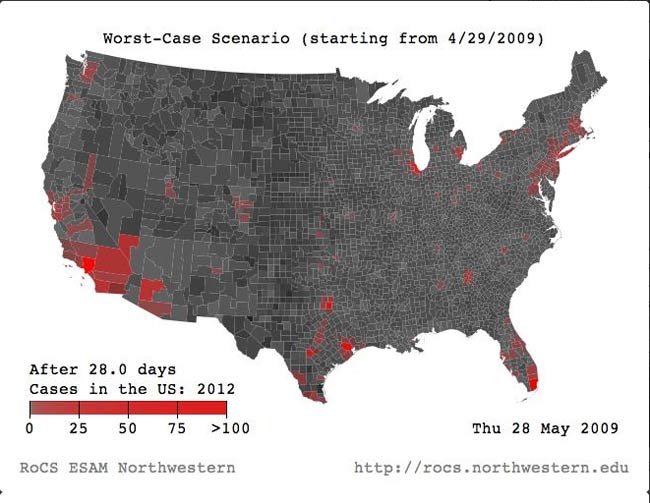'Worst-Case' Scenario for Flu Estimated

There will be about 1,700 U.S. cases of the new H1N1 flu, aka "swine flu," in the next four weeks under a worst-case scenario, according to a research team's new simulations. And a second team working independently, about 200 miles away, on exactly the same question came up with a similar forecast.
As of Thursday, there were 109 lab-confirmed U.S. cases of the new influenza, according to the World Health Organization, which earlier this week raised the risk level of the influenza to one stage below pandemic because the virus is being transmitted within at least two countries in one region of the world. A full pandemic — the virus is also being transmitted within a third country in a different region — is considered imminent.
It is not clear, however, how virulent or deadly this flu strain will become. Flu viruses are unpredictable, and while some in history have proven incredibly deadly, many would-be-pandemics turned out to be quite mild. Also, medicine and public health are more sophisticated today, in terms of treatments and educational campaigns, than they were during the nation's last pandemic flu in 1968, let alone during the Spanish flu of 1918.
Still, researchers are eager to predict what might happen and Dirk Brockmann has identified the hotspots.
California, Texas and Florida will have most of the cases by late May if Brockmann's large-scale computer simulations are right. His group at Northwestern University came up with the figure of 1,700 cases by late May, and also projected more than 100 cases for the Chicago area.
"Remember — that's exponential growth, which means slow at the beginning and then very fast," Brockmann said. "If you run the worst-case scenario for four months, we're at a very different number."
Brockmann's computer clusters can be used to simulate an infectious disease that spreads among 300 million people. The approach was based on human mobility patterns — daily commuting, intermediate trips and long-distance ones — which helps determine how a disease could potentially spread, and he modeled those on data from a dollar-bill tracking project called WheresGeorge.com. You can track people's movements, to a certain extent, if you know where they spend cash.
Sign up for the Live Science daily newsletter now
Get the world’s most fascinating discoveries delivered straight to your inbox.
"These networks play an important role in the spread of infectious disease," he said. "So we're looking at how people travel in the United States and Europe and trying to find a theory behind human traffic. Then we can unravel the structures within these networks and explain them."
Brockmann says his forecast is off by a little bit, and that's a good thing. His team's worst-case scenario assumes that no measures have been taken by officials and public health agencies to combat the spread of disease. Most likely, the case count will be lower than his estimate as a result of such things as stronger public health campaigns for hand washing and social distancing (stand far away from people who are coughing and sneezing), school closures where children are found to be symptomatic and the federal travel advisory against non-essential trips to Mexico. Brockmann and his team's swine flu results match up well with those of a research group at Indiana University in Bloomington led by computer scientist Alex Vespignani. The teams were aware of each other's work but intentionally worked independently and remained ignorant of each other's methodology to see if they arrived at the same results. When scientists independently arrive at the same result, it suggests they have a finding that is "robust," that is it will stand the test of time.
"When we look at the numbers, they are in stunning agreement," Vespignani told LiveScience. "That is very comforting in the sense that it's a sign of robustness. Also it suggests that the results we are getting are probably correct."
The two teams know each other from conferences, but have never specifically collaborated on a published research report, he said. (Brockmann's team includes graduate students Christian Theimann, Rafael Brune and Alejandro Morales Gallardo. Vespignani said there are 20 members of his research team.)
Of course, the H1N1 flu outbreak is still evolving, Brockmann said.
"We have to buy time for the development and distribution of a vaccine, so that is the point, the main issue," Vespignani said.
Vespignani said his team's forecast for the number of cases on May 17 is 1,200 (a public version of his results are at www.gleamviz.org). If you project that rate forward to Brockmann's calculation for late May, when the virus will have spread to even more people, you get a decent alignment, with rounding.
- Video – Worst Case Scenario for Swine Flu
- Top 10 Deadly Diseases That Hopped Species
- All About the Flu
Robin Lloyd was a senior editor at Space.com and Live Science from 2007 to 2009. She holds a B.A. degree in sociology from Smith College and a Ph.D. and M.A. degree in sociology from the University of California at Santa Barbara. She is currently a freelance science writer based in New York City and a contributing editor at Scientific American, as well as an adjunct professor at New York University's Science, Health and Environmental Reporting Program.










